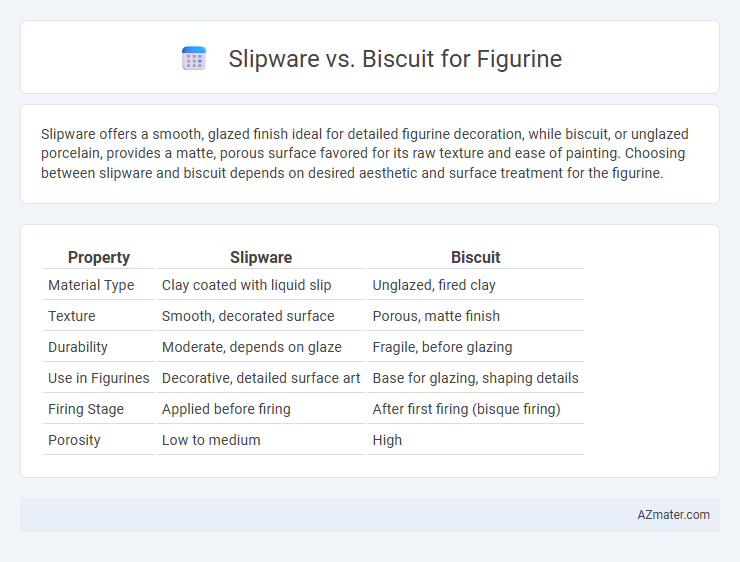Slipware offers a smooth, glazed finish ideal for detailed figurine decoration, while biscuit, or unglazed porcelain, provides a matte, porous surface favored for its raw texture and ease of painting. Choosing between slipware and biscuit depends on desired aesthetic and surface treatment for the figurine.
Table of Comparison
| Property | Slipware | Biscuit |
|---|---|---|
| Material Type | Clay coated with liquid slip | Unglazed, fired clay |
| Texture | Smooth, decorated surface | Porous, matte finish |
| Durability | Moderate, depends on glaze | Fragile, before glazing |
| Use in Figurines | Decorative, detailed surface art | Base for glazing, shaping details |
| Firing Stage | Applied before firing | After first firing (bisque firing) |
| Porosity | Low to medium | High |
Introduction to Slipware and Biscuit in Figurine Making
Slipware in figurine making involves applying a liquid clay mixture called slip to create smooth surfaces and intricate details, enhancing both texture and color options. Biscuit refers to unglazed, fired clay that serves as the base material, valued for its matte finish and durability before any decorative glazing is applied. Understanding the roles of slipware and biscuit is essential for artists aiming to balance aesthetic qualities and structural integrity in ceramic figurines.
Defining Slipware: Techniques and Characteristics
Slipware figurines are created using a liquid clay mixture called slip, which is applied over the surface before firing to achieve decorative finishes with varied textures and colors. This technique allows for intricate surface patterns, including sgraffito and marbling, distinguished by its smooth, often glossy appearance resulting from the slip layering. Slipware's defining characteristics include its vibrant, flowing designs and enhanced surface detail that differ significantly from biscuit figurines, which remain unglazed and matte.
Understanding Biscuit: Properties and Production
Biscuit, also known as bisque, is a type of unglazed ceramic that is fired at a high temperature to achieve a porous and matte finish, making it ideal for detailed figurines with a delicate texture. The production process involves shaping the clay figure, drying it thoroughly, and then bisque firing it between 950degC and 1050degC to remove all moisture and harden the material without adding glaze. Biscuit offers a porous surface that can be painted or left natural, contrasting with slipware, which is coated with liquid clay slip and typically glazed for a smooth, decorative finish.
Historical Context: Evolution of Slipware and Biscuit Figurines
Slipware figurines emerged in the medieval period, characterized by a liquid clay slip applied for decoration before firing, reflecting early ceramic glazing techniques. Biscuit figurines gained prominence in the 18th century, noted for their unglazed matte finish and delicate detailing, often associated with European porcelain manufactories like Meissen and Sevres. The evolution from slipware to biscuit highlights advances in ceramic artistry, transitioning from utilitarian craft to refined decorative art.
Material Differences: Clay Bodies and Compositions
Slipware figurines utilize a liquid clay slip made from fine, refined clay particles suspended in water, allowing for smooth surface decoration and intricate designs, typically applied over a white or colored earthenware body. Biscuit figurines, on the other hand, are made from unglazed, fully fired porcelain or stoneware clay bodies that are denser and less porous, offering a matte finish with delicate detail retention. The primary material difference lies in slipware's use of soft, absorbent earthenware clay coated with slip for decoration, whereas biscuit relies on hard, non-porous clay bodies fired at higher temperatures without surface glaze.
Surface Treatments: Glazing vs. Unglazed Finishes
Slipware figurines feature a smooth, often colorful surface achieved by applying liquid clay slip before firing, allowing intricate designs and vibrant patterns through glazing techniques. Biscuit figurines are intentionally left unglazed, retaining a matte, porous texture that highlights fine details and lends a natural, raw aesthetic prized in collector's pieces. The choice between slipware and biscuit surface treatments significantly impacts the figurine's visual appeal and tactile experience, influencing the final artistic expression.
Artistic Expression: Design Possibilities with Slipware and Biscuit
Slipware offers a rich palette for artistic expression through its use of colored slips and textured patterns, enabling intricate surface designs and vibrant finishes that enhance figurine aesthetics. Biscuit, characterized by its unglazed, matte finish, emphasizes form and subtle details, allowing artists to highlight sculptural qualities and fine craftsmanship without distraction. Combining slipware techniques with biscuit firing expands creative possibilities, blending vivid decoration with refined structural detail for visually striking figurines.
Durability and Maintenance: Longevity Comparison
Slipware figurines, coated with a liquid clay mixture, offer a smooth, decorative surface but tend to be less durable due to their porous nature, making them more susceptible to chipping and moisture damage. Biscuit, or unglazed porcelain, has a dense, vitrified structure that enhances its strength and resistance to wear over time, requiring minimal maintenance to preserve its appearance. For long-term durability and low-maintenance care, biscuit figurines generally outperform slipware, maintaining their integrity and aesthetic appeal through extended handling and exposure.
Popular Styles and Notable Figurine Makers
Slipware figurines, characterized by their colorful, fluid designs created using liquid clay, gained popularity for their vibrant folk art appeal, prominently produced by potters such as Bernard Leach and Michael Cardew. Biscuit figurines, distinguished by their unglazed, matte porcelain finish, are favored for detailed, delicate representations seen in works by Meissen and Royal Doulton. Popular styles in slipware embrace rustic, earthy aesthetics while biscuit figurines often exhibit refined, classical forms, making each technique valuable for different artistic expressions.
Choosing Between Slipware and Biscuit for Your Project
Choosing between slipware and biscuit for your figurine project depends on desired texture and finish; slipware offers a glossy, smooth surface achieved through liquid clay coating, ideal for vibrant glazing and detailed decoration. Biscuit, or bisque, features a raw, porous texture from a single firing without glaze, providing a matte, natural look suitable for painting or further sculpting. Consider slipware for colorful, durable pieces and biscuit for a classic, unfinished aesthetic that allows customization.

Infographic: Slipware vs Biscuit for Figurine
 azmater.com
azmater.com